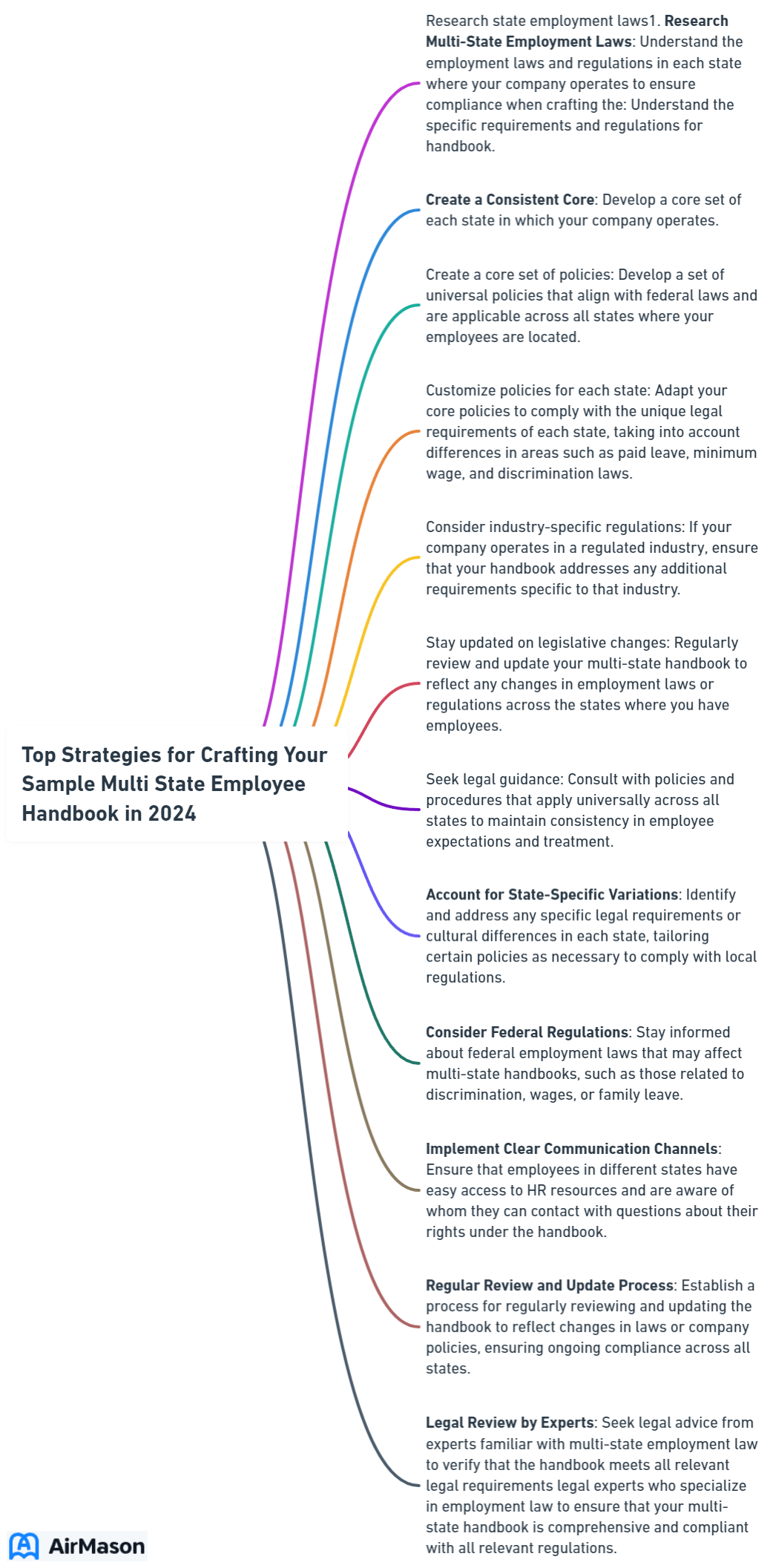
Managing employees across states requires navigating intricate legal nuances. A sample multi-state employee handbook that achieves compliance while reflecting your company culture is indispensable. In this practical guide, discover how to craft policies and frameworks to align with varied state legislations — a vital step towards building a cohesive and legally sound handbook.
Key Takeaways
- Compliant multi-state employee handbooks must include state-specific legal requirements, address federal and state law overlaps, and incorporate protected characteristics to ensure they cater to each jurisdiction’s unique employment protections.
- Employers should prioritize the most generous state laws to standardize policies and respect local norms while updating handbooks to reflect changes and include areas like Paid Family Leave and Sick Leave, and Jury Duty, Witness Duty, and Military Service Leave.
- Organizations should utilize handbook creation software and HR support services for drafting and management, while ensuring legal compliance through regular reviews by employment lawyers and keeping abreast of evolving legislation.
Employee Handbook Revisions
Employee Handbook Revisions are an essential aspect of maintaining an up-to-date and compliant workplace document. These revisions ensure that company policies remain aligned with evolving legal regulations and internal operational changes. Our goal in updating the handbook is to provide clarity and guidance to all employees, fostering a transparent and productive work environment. We encourage feedback from all team members during this process to address any concerns or suggestions for improvement. Additionally, thorough communication and training will accompany these revisions to ensure understanding and adherence to the updated policies. Our commitment to regularly reviewing and revising the employee handbook reflects our dedication to upholding the highest standards of professionalism and fairness within our organization.
Essentials of a Multi State Employee Handbook

A multi-state employee handbook serves as a lifeline for organizations operating across multiple jurisdictions, beyond being merely a document. It provides a clear guide for both employers and employees, outlining crucial policies, procedures, and guidelines. Besides standard policies such as employment, compensation, and code of conduct, it also addresses state-specific employment laws, ensuring legal compliance.
The challenge arises when accommodating immigration law compliance, while still maintaining the company’s unique needs and operational efficiencies. How then, does one go about crafting compliant policies for each state?
Crafting Compliant Policies for Each State
The journey towards crafting compliant policies begins with understanding and integrating each state’s specific legal requirements, which include state employment laws. For instance, an employee handbook for a company in California would need to cover up to 24 state and federal policies, reflecting unique employment protections such as paid sick leave, domestic violence leave, and health safety requirements. Similarly, New York mandates specific protections such as meal and rest breaks, paid time off, and voting leave. However, state laws are not the only considerations. There’s also the challenge of addressing overlaps between federal and state laws.

Addressing Federal and State Law Overlaps
Though federal law takes precedence over state and local laws, states have the liberty to offer more generous provisions, which may lead to tailored adjustments in the company’s overarching policies. Employers often mitigate these legal conflicts by creating umbrella handbooks that adhere to the most generous state laws, ensuring compliance with applicable laws across the board.
For instance, with its state-specific labor laws, particularly regarding overtime, California mandates careful attention to detail in multi-state handbook policies. Inconsistencies in overtime pay between states can result in friction among employees, emphasizing the need for well-communicated policies. Aligning these policies with protected characteristics is equally critical.
Incorporating Protected Characteristics
Protected characteristics must align with federal anti-discrimination laws, and they are integral to creating an inclusive work environment. For instance, Utah employee handbooks should recognize these characteristics as per federal standards. However, some states have additional requirements. In California, handbooks must include provisions for lactation accommodation and pregnancy leave. Similarly, policies in New York must outline Lactation Accommodation and Family and Medical Leave Act (FMLA) policies to ensure compliance with state-specific protected characteristics.
That said, navigating employment laws across multiple states is a challenge in itself.
Navigating Employment Laws Across Multiple States

Finding a path through the maze of state-specific requirements can be overwhelming. Some of these requirements include:
- Minimum wage regulations
- Overtime regulations
- Anti-discrimination policies
- Unique state mandates for leaves and benefits
Updating handbooks to reflect changes in state laws, while ensuring consistency across the organization, only adds to these challenges. The rise of remote work has further complicated multi-state compliance, as remote employees working from different locations bring additional state laws into the equation.
Especially in complex landscapes with stringent requirements like in New York, seeking advice from legal experts is paramount. Let’s delve deeper into some of these areas.
Paid Family Leave and Sick Leave
Paid family leave and sick leave policies vary significantly across states, making them a key area to address in multi-state handbooks. Here are some examples of state policies:
- In D.C., new parents are offered up to eight weeks of paid leave, along with an additional two weeks for prenatal care.
- New Jersey mandates paid medical leave, ensuring employees have state-mandated benefits.
- Massachusetts recently updated its Paid Family Leave program.
- California has an updated paid sick leave law.
These examples highlight the importance of staying up to date with state policies and making necessary updates to employee handbooks.
However, variations are not limited to leave alone; policies concerning Jury Duty, Witness Duty, and Military Service Leave also differ from state to state.
Jury Duty, Witness Duty, and Military Service Leave
Even federal policies such as Jury Duty Leave and Military Service Leave can have state-specific requirements. For instance, New York and California require these policies to be included in employee handbooks. Local laws, like San Francisco’s Military Leave Pay Protection Act and recent Illinois legislation, may necessitate adjustments to leave policies.
These leaves, along with others like parental leave, should generally be included in handbooks. With the variety of state laws, building consistency while respecting local norms becomes a key priority.
Building Consistency While Respecting Local Norms

Achieving a harmony between consistency and respect for local norms is crucial to fostering a fair work environment. Standardizing policies across all states, maintaining workforce morale, and emphasizing fairness as a core company value can prevent confusion and potential legal issues. This means creating fair guidelines by writing policies based on the most generous laws and regulations, ensuring that no state’s legal requirements compromise the fairness due to other employees.
A fair work environment cultivates positive employee experiences, subsequently boosting engagement and productivity. Let’s explore how this balance can be achieved.
Standardizing Rest Breaks and Work Hours
State laws concerning meal and rest breaks vary widely, necessitating adherence to diverse regulations. For example, California mandates a 30-minute meal break for shifts over five hours, and a 10-minute paid rest break every four hours. Colorado and New York impose their own unique requirements. Beyond break times, California prescribes policies on an array of issues, from health and safety to whistleblower protection, impacting company-wide policies.
Balancing consistency and respect for individual state laws is vital in standardizing rest breaks and work hours.
Harmonizing Anti-Discrimination and Harassment Policies
Anti-discrimination and harassment policies play a critical role in creating a fair and inclusive work environment. A landmark court case from May 2021 underscored this need. Companies must tailor these policies to comply with the specific laws of each state. For instance, Colorado redefines sexual harassment standards and includes marital status as a protected employment category.
The employee handbook’s code of conduct should include the following:
- Treating all individuals with dignity and respect
- Strictly prohibiting any form of discrimination or harassment
- Clear definitions of harassment, confidentiality, impartial investigations, and protection against retaliation
However, these considerations bring legal implications.
Legal Considerations in Your Multi State Employee Handbook

Legal considerations significantly influence the drafting of an employee handbook. Including federal laws such as the Fair Labor Standards Act (FLSA), Equal Employment Opportunity Commission (EEOC) guidelines, and Family and Medical Leave Act (FMLA) is critical, as they safeguard essential worker rights. However, employment laws vary across states, posing potential compliance risks that must be managed.
Legal experts can offer their guidance on universal policies, while ensuring compliance with all relevant laws and regulations, and maintaining consistency. Let’s delve deeper into these legal considerations.
Consulting with an Employment Lawyer
Consulting with an employment lawyer is fundamental to ensuring legal compliance and consistency in a multi-state employee handbook. Lawyers can help navigate differing state and local employment laws by prioritizing the most generous laws, consulting an employment lawyer, and regularly reviewing and updating the handbook. Legal changes such as the legalization of marijuana in some states have led to the need for adjustments in drug policies. It’s a best practice to have multi-state employee handbooks reviewed by outside legal counsel.
However, engaging a lawyer is only the first step; keeping track of legal developments is of equal importance.
Monitoring Legal Developments
Keeping up with any changes in labor laws and regulations is a necessary part of managing a multi-state employee handbook. Significant employment law developments for 2024 include proposed increases in salary thresholds for overtime exemptions and greater enforcement efforts from the EEOC. Updates in handbooks should reflect current state-specific legal requirements.
Tracking evolving state and federal legislation remains a significant concern for multi-state employers, complicating the process of maintaining legally compliant employee handbooks. With these legal considerations in mind, leveraging the right tools and resources plays a crucial role in creating an effective handbook.
Tools and Resources for Multi State Employers

Drafting a multi-state employee handbook can be an overwhelming task, yet there are numerous tools and resources at disposal to ease the process. From specialized software that streamlines the process to HR support services that manage multi-state employment policies, these resources are invaluable for multi-state employers. However, it’s important to remember that user satisfaction with these platforms can vary.
While the initial investment might seem high, the benefits of compliance and efficiency in managing multi-state employment policies more than offset the costs.
Handbook Creation Software
Handbook creation software can significantly simplify the process of crafting a legally compliant multi-state employee handbook. These platforms offer features like:
- Document management with version control
- Collaborative editing
- Customizable templates
- Search capabilities
These features are essential for efficient handbook management. Employers benefit from a centralized repository for handbooks, user-friendly interfaces, and cloud-based accessibility, ensuring a remote or distributed workforce stays informed.
Specific solutions offer up-to-date HR-approved language and state and city-specific policies, proving invaluable in managing handbook versions effectively.
HR Support Services
HR support services can provide additional help in managing multi-state employment policies. In an effort to boost operational efficiency, many multi-state employers are turning to professional employer organizations (PEOs) to outsource certain HR tasks. This allows them to focus on core business activities while benefiting from specialized HR support. Services such as Employer of Record (EOR) and global compliance HR support streamline global payroll processes and support hiring employees from a significant number of countries. Specialized HR and compliance services offer services for multi-state payroll processing, recruitment, and benchmarking.
Ensuring these services are scalable is crucial as they must accommodate an organization’s growth and the complexities that come with adding new states or locations. Once you have the right tools and resources, implementing your handbook becomes the next step.
Implementing Your Multi State Employee Handbook
Implementing a multi-state employee handbook goes beyond mere distribution of copies. It requires:
- Training HR teams and managers on policy consistency and uniform application
- Ensuring the handbook is not just a document but a living, breathing guideline for the organization’s operations
- Understanding the rationale behind each policy is key to consistent enforcement and communication to employees.
State-specific training is also essential to ensure full understanding and compliance with variabilities in state laws. The employee handbook serves as a defense against potential legal issues by clearly informing employees of their rights and obligations.
Training Human Resources and Management
For HR teams and managers implementing a multi-state employee handbook, training on policy consistency is imperative. This includes understanding the differences in employment laws that impact policies and how to apply these laws to the staff consistently. In addition, making digital resources available to staff ensures consistency and clarity.
Managers should also be trained to:
- Manage at a distance
- Avoid remote work bias
- Lead team members who are remote
- Create career paths for remote employees
The next step is ensuring that the handbook is accessible to all employees.
Distributing the Handbook to Employees
The distribution of the employee handbook extends past the mere handing out of printed copies. A centralized communication hub, such as an intranet or team collaboration software, can be used for distributing the employee handbook. Software platforms enable the creation of multi-language versions of handbooks, catering to the needs of a diverse workforce.
The employee handbook should be digitally accessible with state-specific addendums to communicate each employee’s rights according to their working state. For offsite staff, it’s essential to display federal and state laws digitally, as physical posters in an office would not be accessible to them.
Summary
Crafting a multi-state employee handbook is a challenging yet rewarding endeavor. From understanding the essentials and navigating state-specific laws to balancing consistency while respecting local norms, it requires a fine balance. Using the right tools and resources, consulting with legal experts, and implementing the handbook effectively can make this task manageable. A well-crafted handbook not only ensures legal compliance but also fosters a fair and inclusive work environment. The journey may be complex, but the result is a handbook that serves as a sturdy foundation for a thriving, multi-state organization.
Frequently Asked Questions
What is a multi-state employee handbook?
A multi-state employee handbook is a comprehensive document that outlines policies, procedures, and guidelines for organizations operating in multiple jurisdictions, addressing the unique legal requirements and regulations of each state. It is designed to ensure compliance and consistency across different locations.
How can employers manage differing state and local employment laws?
Employers can manage differing state and local employment laws by prioritizing the most generous laws, consulting an employment lawyer, and regularly reviewing and updating the handbook for compliance.
What services do professional employer organizations (PEOs) offer?
Professional employer organizations (PEOs) offer a range of services, including global payroll processes and multi-state employment policy management to assist in hiring employees from various countries.
Important Disclaimer:
Please be aware that the content on this page has been generated by using artificial intelligence language models and may contain errors, inconsistencies, or outdated information. It is provided as-is without any warranties or guarantees of accuracy.
We strongly recommend using this content as a starting point for further research. We disclaim any liability for damages or losses resulting from the use or reliance on this content.